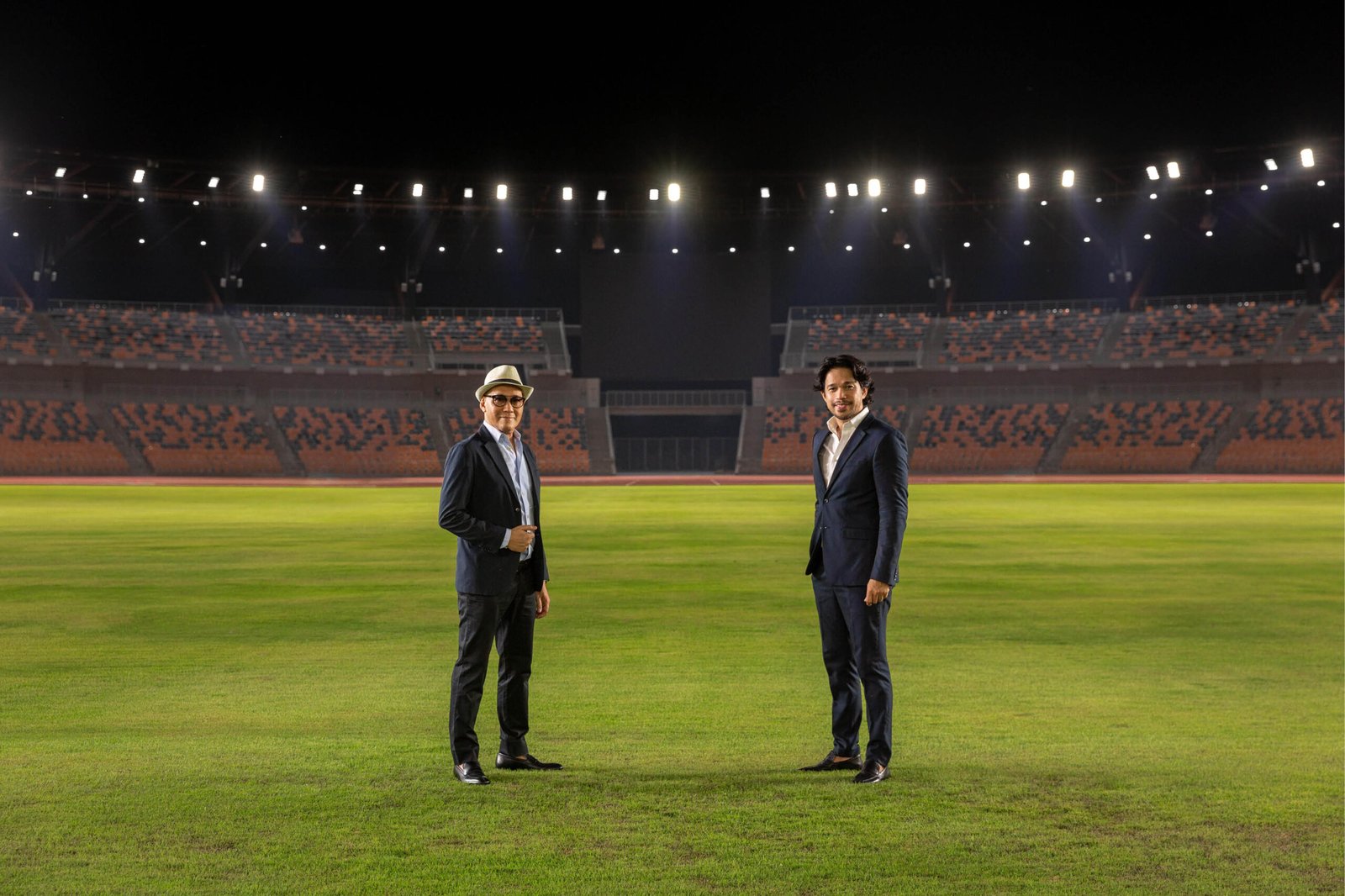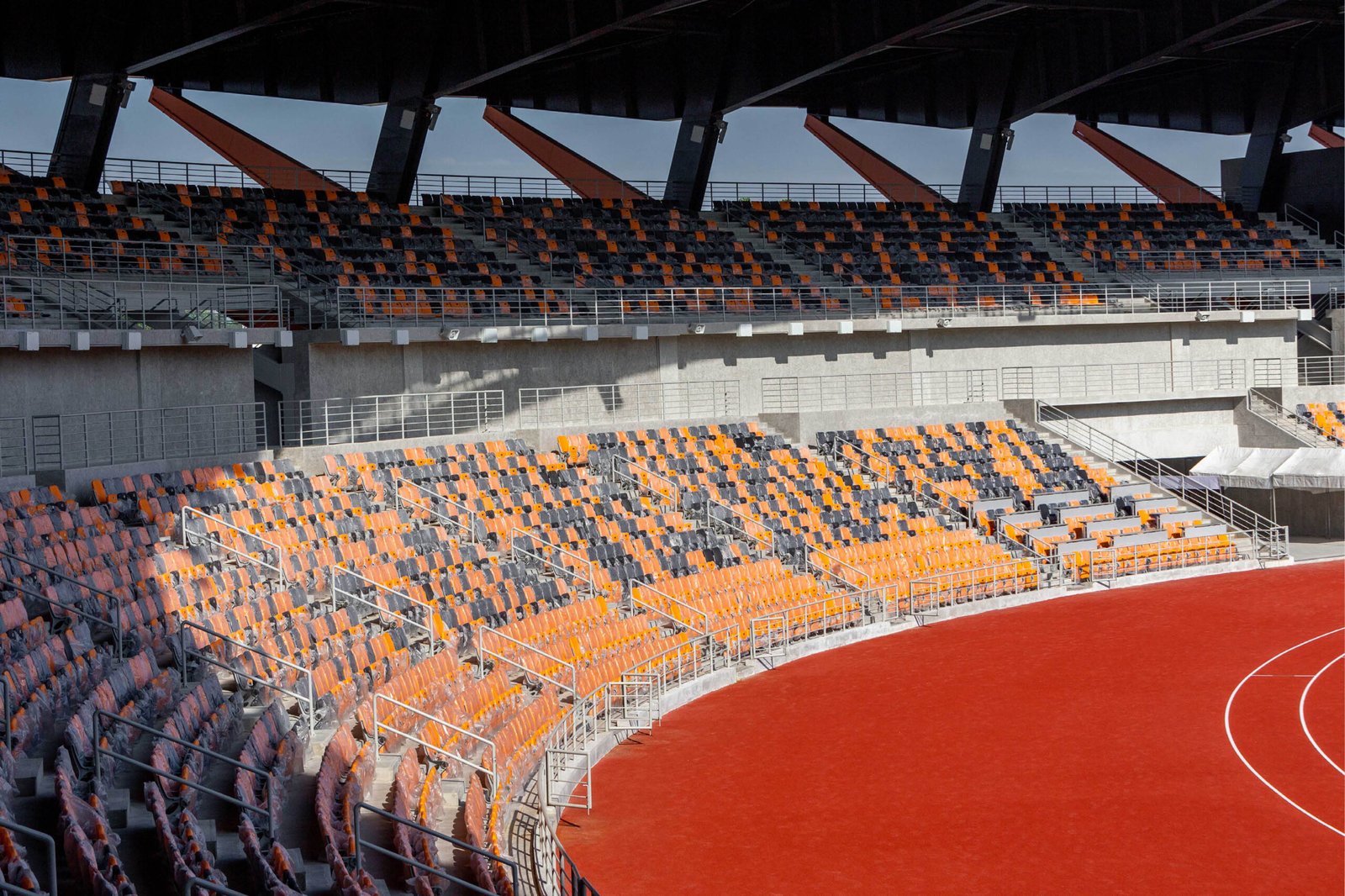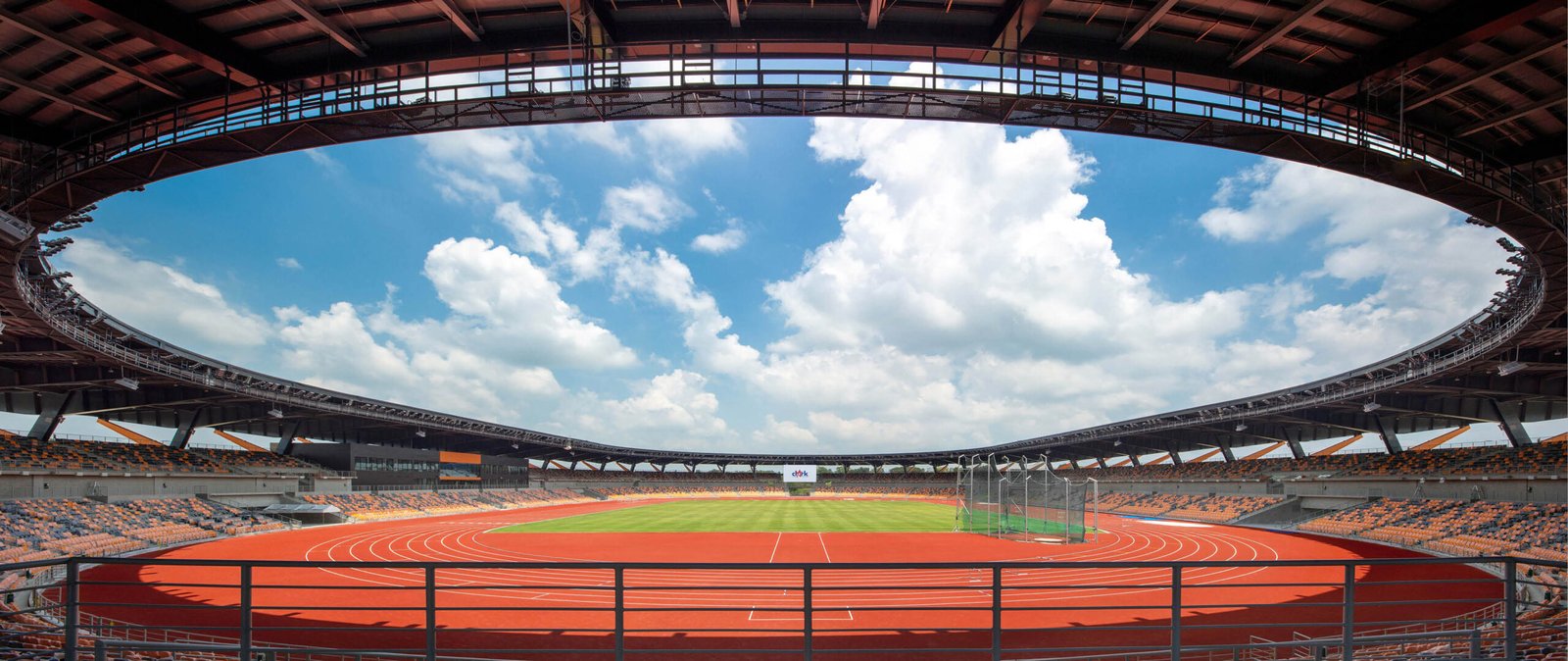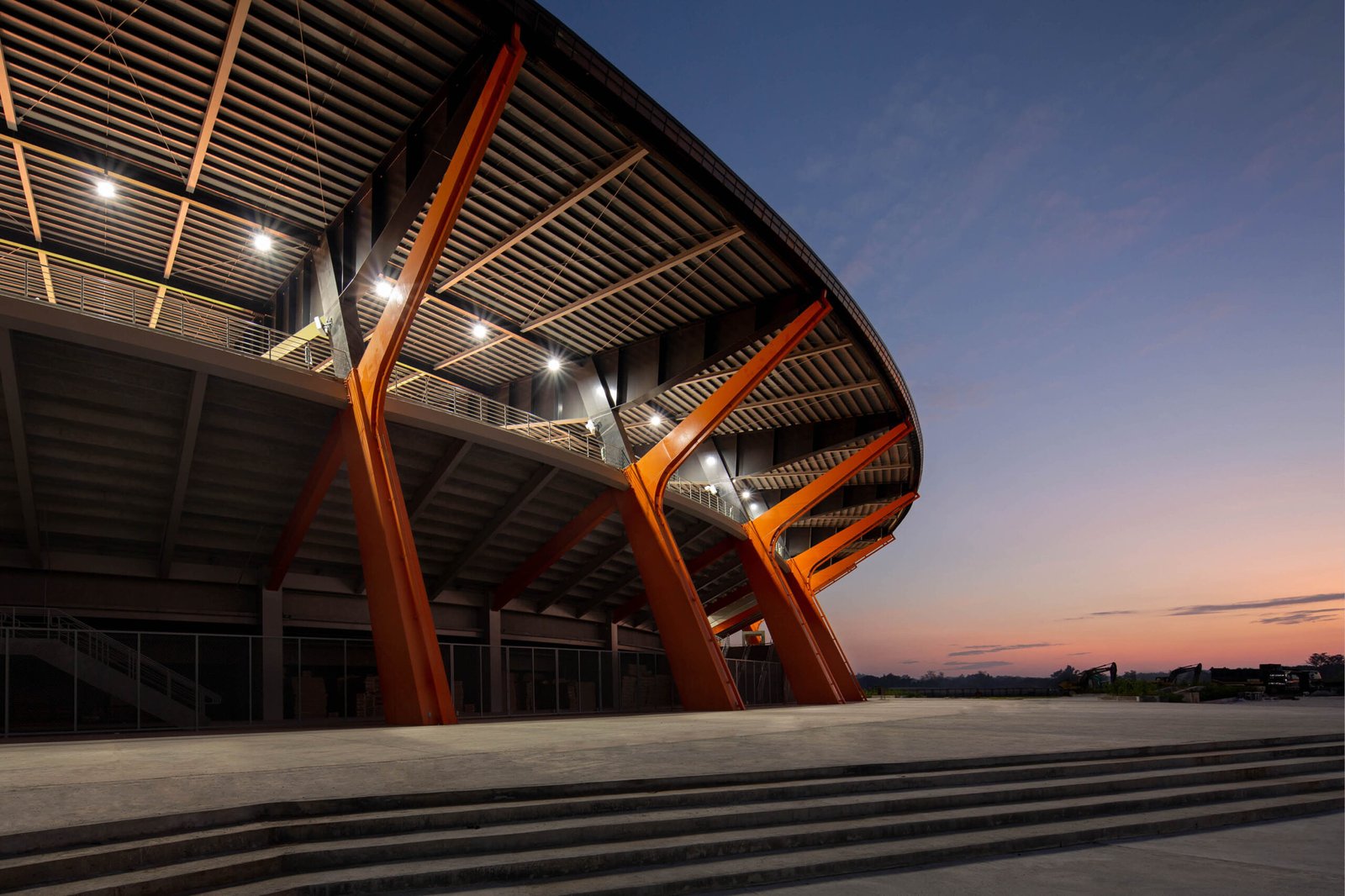Photography Marc Henrich Go, Eric Beltran, and Kevin Evora for BUDJI+ROYAL Architecture + Design


The World Architecture Festival announced today that its jurors have included designer Budji Layug and architect Royal Pineda’s New Clark City Athletics Stadium in the shortlist of Completed Buildings in the Sports category. This means the partners are invited to present their design before a live audience and jury in Lisbon, Portugal, from December 1-3.
The World Architecture Festival is the largest and one of the most prestigious international architecture competitions in the world. On the first two days of the festival, 148 judges from 68 countries will judge over 500 shortlisted entries in 17 categories. Architects that win in their category will then face a Super Jury on the third day to compete for Building of the Year or Future Building of the Year.
BUDJI+ROYAL Architecture+Design made a name for itself in the 1990s designing some of the country’s most beautiful modern tropical residences. The past decade has seen the firm undertaking much more complicated projects and landmarks—airports, bridges, the New Clark City Sports Complex, which houses the Aquatics Center and the shortlisted Athletics Stadium, the National Government Administrative Center in Capas, Tarlac, and the Philippines Pavilion for the Expo 2020 Dubai.
The Stadium is one of seven Philippine projects to be shortlisted at WAF 2021—four Future Projects and three Built Projects. The project description follows, along with the images the firm submitted to the WAF, and an interview with the partners.


A Natural Catastrophe Leads to Authenticity, Spurring Identity, and National Pride
The 20,000-seat Athletics Stadium is the centerpiece of the Sports Complex in New Clark City, the Philippines’ first world-standard smart and sustainable city. Located in Capas, Tarlac, northwest of Manila, the complex was built to host the 2019 Southeast Asian Games, and designed to articulate a national identity through an authentic process of highlighting local symbols, Filipino ingenuity and resilience, and harmony with its tropical environment.
Governed by the philosophy of nature as inspiration, nearby Mount Pinatubo, a striking symbol of the area, forges the stadium’s essence. Causing the second-largest volcanic eruption of the 20th century, Mount Pinatubo buried towns in 5-cubic kilometers of lahar in 1991, displacing thousands. The socioeconomic impact was devastating, but from destruction comes recreation as the country rose from the ashes.
A testament to the Filipino’s resilience and creative resourcefulness, the stadium echoes Mount Pinatubo, from its graphite caldera of a continuous roof to the orange and gray lava pixels of the seating and playing field, evoking an active volcano’s energy. The unprecedented use of lahar (in its concrete mix and as finishing material) transforms remnants of disaster into building blocks of a flourishing development.
The structural members are its architecture. Integrating engineering and architectural innovations, fifty modular structural bays are formed by diagonal composite columns, each sporting a patented “Active Orange” paint that radiates the adrenaline-filled competition atmosphere. Eleven rows of seats on the lower level are made of reinforced concrete, while the upper ring of ten rows is supported by prefabricated steel which also carries the cantilevered roof. These angular T-Frame pillars recall the bamboo frames of parols—traditional Christmas star lanterns the region is famous for—and are the defining architectural feature. The canopy is raised atypically higher for maximum permeability to address the tropical climate with passive cooling and take advantage of nature’s views.




Built on a modest USD 78 million budget and the Filipino sensibility of practical luxury, aesthetics, and function meld beautifully with simple materials and design innovation. The application of future upgrades is simplified since the architecture sets aside cladding and forms its unique aesthetic through bare building materials. Lahar concrete left unpainted, enriches its contextual architectural narrative while keeping maintenance to a minimum.
The country’s first IAAF-certified world-class facility set new government standards through modern Filipino design, construction speed and quality, and technology. It renewed national pride for its record-breaking 18-month development (from conceptualization to modular construction and accreditation), a gift for athletes who will continue to use this as a national training center, and for all Filipinos who see this as a symbol of inspiration, hope, resilience, and progress.
Engineered to withstand up to 8.9 magnitude earthquakes, the Athletics Stadium is also envisioned to become an evacuation center in preparation for the “Big One” that is expected to cause liquefaction of the government seat in Manila. Responding to the times, the complex is being readied and repurposed to house quarantine facilities during the pandemic.


Congratulations, Budji and Royal! How did you react upon first hearing the news?
Budji: So surprised and excited for the firm. It has been a dream.
Royal: I was very thankful. Of course, it wasn’t really expected. I did not want to expect! (Laughs) I was thanking God for the blessings He has given us. We just felt we needed to submit to share that design globally. More than anything, it is an effort to promote Modern Filipino Architecture+Design. It is there, not to compete, but to be shared.
It’s similar to how we felt presenting our country at the Expo 2020 Dubai. We wanted to do so as truthfully, as honestly as we can. What’s nice with WAF is architects and designers comprise the jurors and audience, who will be able to appreciate and understand the language of your creation.
What’s your mission for Lisbon?
Budji: To allow the world to see the vision and ingenuity of Filipino artists, architects, and designers, to recognize Filipino creativity. No pressure! For me, this is a continuation of our efforts to design the country for the future, to bring it to first-world level, and make the world appreciate the Filipino design sensibility.
Royal: The internal pressure is much more intense. We advocate modern Filipino architecture and design locally, so it is very exciting to be able to speak of it in front of international colleagues, and distinctively show its authentic nature and identity globally. It’s a good opportunity to present our country, especially since the Athletics Stadium is a government project. We want to present the Philippines as truthfully as we can. Get to the very root of that authentic Filipino in this particular project and convey it in a way that is understandable and legible for the audience.




What do you think the biggest challenge will be when presenting to the judges?
Budji: What modern Filipino design is. And the resiliency and resurgence narrative.
Royal: The real challenge for me is to make them understand through architecture and design where we are as a country and our status as a people—what our aspirations and memories are. It’s very important because the judges will appreciate the value of your creation if they appreciate for whom the work was created. I think it is how much you cared for the user and the people themselves that counts.
I think they will easily understand the soul of the design in terms of the project’s expression of truthfulness. And the personality and identity that the Philippines brings to the variety of the world. This is what makes us equally important to the rest of mankind.
They might not understand the concept of practical luxury, a value we advocate that shaped our design. Knowing the status of a developing country may be foreign to people from first-world countries. One has to understand and relate to the needs of the people and the status of the nation.
I remember from our visits to the Stadium how breezy it was, and in the toasty weather of Tarlac, that’s an impressive achievement. What else speaks of good problem-solving that the judges should be made aware of?
Budji: Being one with nature led us to also bring natural light in, create openness of the spaces to integrate the outdoors, and generate significant savings on operating expenses. Maintenance is made minimal largely because of the lahar component, choices of organic finishes, systems, and the material specs used.
Royal: Aside from the tropicality of the design, it’s important for them to understand the concept of practical luxury and how this addresses the lifestyle of the Filipinos through using available resources. Being a government project, the Athletics Stadium is expected to be prudent and cost-conscious at the same time. We took the opportunity to trigger our desire to define a Filipino identity that is progressive and authentic in the present times and to challenge the discomfort and confusion of many about not having Filipino architecture. The stadium was constructed to host the 30th Southeast Asian Games, so it became a platform for us to present the Modern Filipino sensibility on a grander scale, in a more public space, with a global audience.
I hope very much to see you in December! What will you bring with you from Manila, and what will you take home from Lisbon?
Budji: I am bringing the sensibility of a Filipino artist and designer. Together with Royal. I will bring Modern Filipino design and architecture to Lisbon.
Royal: I’ll bring with us pride. And bring home learning. •






5 Responses
the design of the stadium was so nice also they can expand it to a much more seating capacity like the other stadiums in the world!!